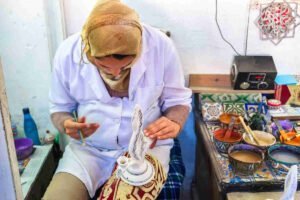Mandala Tours group agencies are not only experts in designing routes full of beauty, but also in showing the local culture of each place. And in this sense, there is nothing better than gastronomy to ‘savor’ the tradition of a people. In this post we give you a sample of what your palate can discover with us: typical sweets that you will surely find and taste during your trip.
Arab and Turkish pastries, interrelated
In the vast and heterogeneous world known as the Middle East, it can be said that there are two great culinary traditions that, in many cases, go hand in hand. On the one hand, Arabic pastries and, on the other, Turkish pastries. The reason for this interrelationship is none other than their geographical proximity and the long period of Ottoman domination of the region in the past. In addition, the common majority religion, Islam, has also helped to spread and consolidate some of the typical sweets in the area.
Some of the characteristics that can be highlighted in both is the taste for nuts, which are present in most sweets. Filo pastry or puff pastry is the basis for many of the creations. And cream cheese or different types of creams, including angel hair and syrup, are often used to give a special consistency to cakes.
One of the sweets that Turkey, Egypt and Jordan have in common is baklava. baklava . It probably has a Turkish origin, where there are shops specialized in it: they are small sweets made of filo pastry, dried fruits and syrup bath. In Egypt they have a passion for the ruz bi laban (rice pudding) and mahallabiye (custard with pine nuts and almonds). And if there was one from Jordan to be singled out, it would be the knafeh (semolina dough, butter, cream cheese, syrup and grated pistachio). And if it is very hot, nothing better than the booza a kind of ice cream with a gummy texture, usually with orchid extract.
On the other hand, if you are traveling in Morocco, you will have the opportunity to taste the ‘national’ sweet, the chebakia. chebakia a spiral-shaped sweet whose dough contains flour, butter and egg, and can be topped with toasted almonds, honey and sesame. The briwat (stuffed pastries in the shape of a pie) can also be a good option to treat yourself and snack between meals, as they are offered as a snack at large celebrations.
The taste of other religions
As we were saying, Islam has helped to spread and consolidate some of the aforementioned sweets in popular culture, since some of them are associated with the rbreaking of the fast in Ramadan (Iftar) or a hearty and energetic breakfast in the mornings of this important period for Muslims. For example, the konafa in Egypt (fresh cheese cake, pistachios and citrus syrup) or the sfenj in Morocco (a kind of fried doughnut).
If you travel to Israel, you will find striking resemblances to the pastries described above, but there are certainly Jewish offerings of their own. Above all, the rugelach : small sweets shaped like croissants… but with a very different taste, thanks to their dough rolled with flour, butter and cream cheese (sour cream, in some cases), and especially to their filling of jam, raisins, chopped nuts or even chocolate, to taste.
Finally, a unique sweet that you can also taste is the kahkthe typical cookie of the Coptic Christian community in Egyptespecially during Easter: its dough of flour and butter, sugar and yeast can be filled with walnuts, pistachios, dates or the ever-surprising agameyaHoney, walnuts and ghee (clarified butter) are mixed until a unique texture is achieved.





